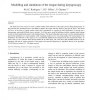Free Online Productivity Tools
i2Speak
i2Symbol
i2OCR
iTex2Img
iWeb2Print
iWeb2Shot
i2Type
iPdf2Split
iPdf2Merge
i2Bopomofo
i2Arabic
i2Style
i2Image
i2PDF
iLatex2Rtf
Sci2ools
100
Voted
CN
1998
1998
Modelling and simulation of the tongue during laryngoscopy
The main aim of our work is to create a realistic model of the behaviour of the upper airways during laryngoscopy. In this procedure the anaesthetist uses a rigid blade to displace the tongue and then inserts a tube into the larynx. The model will serve as the basis of virtual systems which allow anaesthetists to visualise the likely difficulties in carrying out a laryngoscopy, and predict difficult cases in advance. It will also prove useful in building a realistic computer based training system in which anaesthetists interact with simulated tissues. Web-based technology can be used to set the model parameters and run the simulation on a remote machine, while visualising results on a low cost local machine. The main property to be modelled is the behaviour of the tongue as it is mechanically displaced and compressed by the laryngoscope blade. To achieve this, we have used the finite element method in an initial study. The work shows that plausible behaviour can be simulated, and that...
Anaesthetists | CN 1998 | Main Aim | Realistic Model |
| Added | 21 Dec 2010 |
| Updated | 21 Dec 2010 |
| Type | Journal |
| Year | 1998 |
| Where | CN |
| Authors | Maria Andréia F. Rodrigues, Duncan Fyfe Gillies, P. Charters |
Comments (0)

